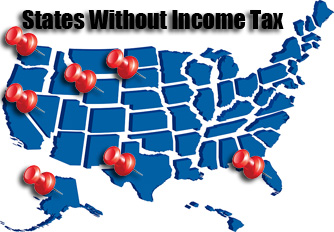As Benjamin Franklin said, “The only things, certain in life are death and taxes.” For the most part, he is right as the US Federal government has been taxing citizens in various ways with the most substantial being the income tax (1913). Of course, let us not forget about State taxes, city/towns, and municipal taxes as these add to the burden most US citizens endure to fund government services. However, in some states, there are no state taxes levied on income, while in other cases governments collect taxes on dividend and interest income only.
States Without Personal Income Tax
In the United States today seven out of the 50 states do not impose any form of personal income tax. These states have attracted many citizens as well as businesses. Some states with no income tax were recently challenged, like in Washington this past election.

- Alaska, Florida, Nevada, South Dakota, Texas, Washington, and Wyoming Have No Income Tax
- Tennessee and New Hampshire tax only dividend and interest income
The remaining 41 states do have a personal income tax system. Many have what is called a progressive income tax system. It means that the income tax rates rise as the personal income rises. The more income an individual makes, the more taxes they are required to pay, according to the laws of their state.
States that Have Low Taxes Growing Quickly
It should be no surprise that the states with no taxes or lower taxes are growing much faster than those states with high taxes. Americans for Tax Relief did this study. What is interesting is that of the seven states with no income tax, 4 of them (Texas, Florida, Nevada, and Washington) are all growing are projected to pick up one congressional seat except for Texas which is to pick up four seats.
States that Hae the Highest Income Tax Rates
According to statistics, income taxes range a great deal from state to state. A few states have significantly higher taxes than others across the country.
California
In California, there are six tax brackets. The income tax percentages range from the lowest at 1.25% for an individual that makes $7,168 and can go up to 10.5% for individuals who make more than 1 million dollars annually.
Hawaii
Hawaii has 12 different tax brackets that determine the personal income tax amount. The lowest tax bracket begins at 1.4% which is $2,400, with the high being 11% or $200,000 for income that exceeds $400,000.
Rhode Island
Rhode Island has five different tax brackets, and the tax rates range from a low of 3.75% to a high of 9.9%.
Oregon
Oregon has three separate tax brackets that start at the low of 5% and range up to 11%. Income over $250,000 may be subject to the maximum 11% tax. This amount is estimated to rise in 2011 but not to exceed 11%.
New York
New York has five tax brackets. The tax rate range at the low is 4.0%, and the high is 8.97%. Households that exceed a taxable income over $500,000 are subject to the highest tax rate regardless of filing status.
Consider All the Factors
Taxes both Federal and State are a concern for the nation, but the State imposed personal income taxes are not the only thing that determines affordability. While state taxes are a significant factor to consider when deciding where to live, to move, or retire, this should not be the only factor when analyzing the cost of living and affordability in a particular state or county.
The truth is that people who can’t afford their taxes can find themselves in a world of financial trouble and some states that have low personal income taxes have skyrocketing state sales taxes or property taxes. When determining the affordability of the cost of living, it is essential to look at the following factors in addition to personal income taxes.
- State Sales Tax
- State Property Tax
- Tax Deductions
- Exemptions
The burden of paying taxes comes in many forms. According to research done by the Tax Foundation in 2010, it is estimated that the country as a whole will pay on average 9.7% of its yearly income in state and local taxes. New Jersey residents were expected to pay the most in state taxes across the nation at an average of 11.8% while Alaska was at a low of 6.4%.

